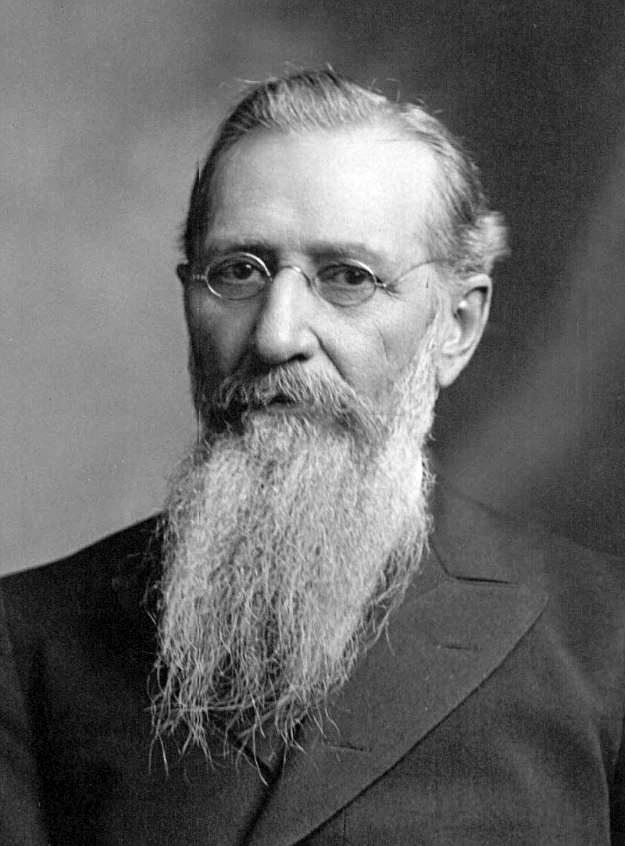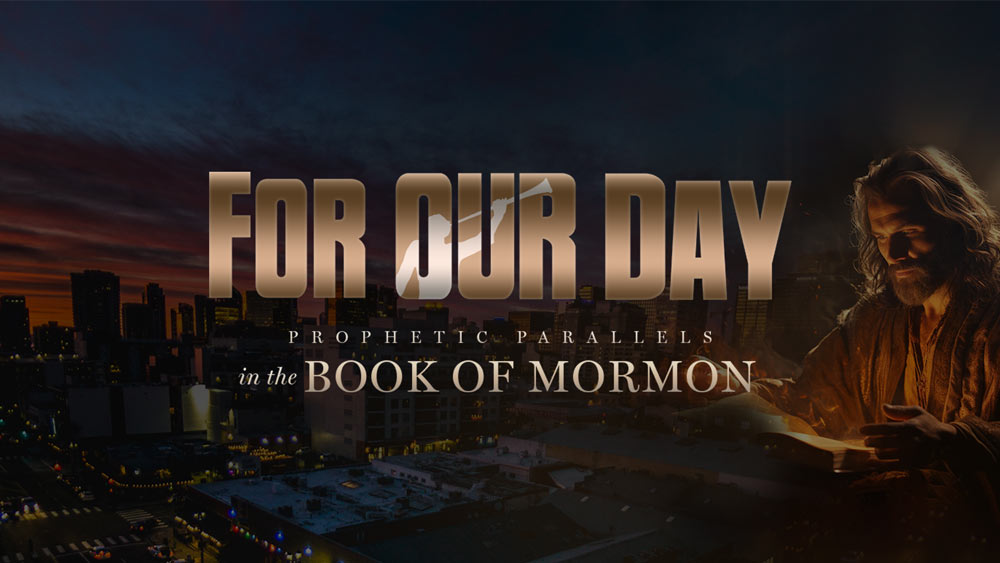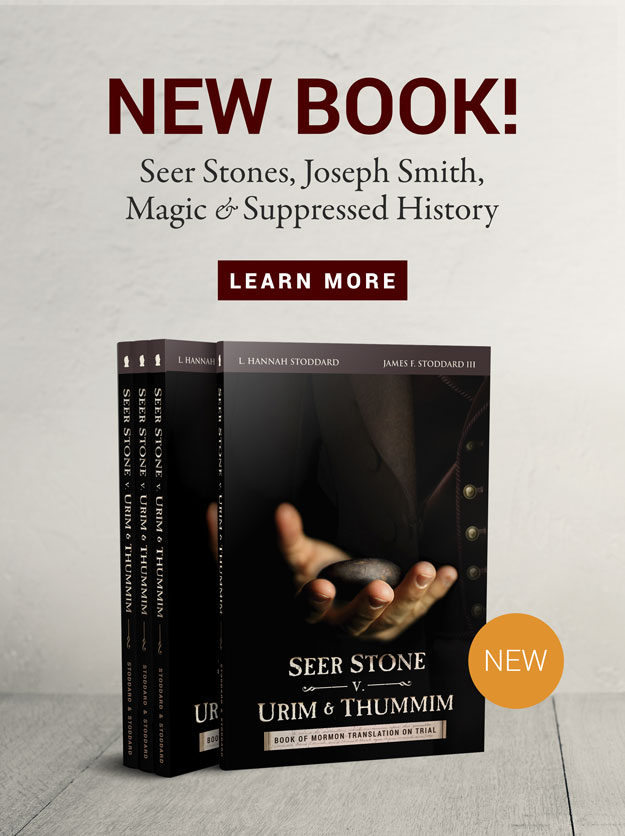Answer the Call
For Our Day Parallel
Book of
Mormon
Sharem Denies Revelation and the True Christ, circa 544-421 B.C.
For
Our Day
Creeds Deny Revelation & the True Christ, ~325-1820 A.D.
Lesson 15: Sherem's Antichrist Teachings & Parallel Apostate Christian Creeds
Video will become available on April 3, 2024.
Set the Course
“Is the Book of Mormon true? Yes. Who is it for? Us. What is its purpose? To bring men to Christ. How does it do this? By testifying of Christ and revealing his enemies.”
Ezra Taft Benson, "The Book of Mormon Is the Word of God," Ensign, May 1975, 63.
Sherem, an Antichrist
Written by James F. Stoddard III
In Nephite history there were many antichrists who came among the people and taught their false philosophies. All of these men were cunning, possessing great power of language and charisma. As we study the Book of Mormon parallels, we begin to notice important patterns. For example, the teachings of Sherem—and later a similar ideology among the Zoramites—can be compared to the false creeds of apostate christianity that negatively influenced the early colonists of America as well as the 19th-century Christians at the time of Joseph Smith. These beliefs continue to cause confusion and incite contention today. In Jacob 7, Sherem declared that there was:
- no Christ,
- no current revelation,
- no Holy Ghost with spiritual gifts,
- that it was blasphemy to claim to know the future,
- and that the correct path lay in keeping the hollow form and ritual of the Law of Moses.
Sherem possessed a “perfect knowledge of the language of the people; wherefore, he could use much flattery, and much power of speech, according to the power of the devil.” (Jacob 7:4) He also labored diligently to lead away the hearts of the people and contended warmly with Jacob, a prophet of God.
Jacob, the brother of Nephi, could not be shaken as he had received many revelations from the Lord, seen angels and heard the voice of the Lord speaking in word, thus having a sure knowledge of the Gospel that he taught.
The doctrine of Sherem in the Book of Mormon corresponds with the early religious landscape of this dispensation. Nephi after seeing this parallel in vision noted:
And they shall contend one with another; and their priests shall contend one with another, and they shall teach with their learning, and deny the Holy Ghost, which giveth utterance. . . And they deny the power of God, the Holy One of Israel; and they say unto the people . . . Behold, hearken ye unto my precept; if they shall say there is a miracle wrought by the hand of the Lord, believe it not; for this day he is not a God of miracles; he hath done his work.
Note the similarities in this record with the experiences of the Prophet Joseph Smith:
Some few days after I had this vision [the First Vision], I happened to be in company with one of the Methodist preachers, who was very active in the before mentioned religious excitement; and, conversing with him on the subject of religion, I took occasion to give him an account of the vision which I had had. I was greatly surprised at his behavior; he treated my communication not only lightly, but with great contempt, saying it was all of the devil, that there were no such things as visions or revelations in these days; that all such things had ceased with the apostles, and that there would never be any more of them.
The religious teaching in the day of the Prophet was described by the Lord as a time when:
. . . they draw near to me with their lips, but their hearts are far from me, they teach for doctrines the commandments of men, having a form of godliness, but they deny the power thereof.
The general population claimed to worship Christ, but in many cases the God that was actually worshiped was devoid of body, parts, and passions—He was utterly powerless. He neither spoke nor acted and was thus no God at all. The form of the true faith had been passed down among the people, just as the form of the Law of Moses had been passed among the Nephites, but there was little else. Many of the ministers of the day were trained by schools of the land in eloquence and the use of language to move audiences, but did not accept the power of the Holy Ghost which carries the truth into the hearts of true believers.
Thomas Jefferson & John Adams Challenge False Creeds
Fascinatingly, some of the early founding fathers were so attuned to the spirit of God that even before Joseph Smith appeared on the scene they recognized that Christianity had been corrupted. Two primary voices were John Adams and Thomas Jefferson. During some heated political battles, these two friends became alienated. However, they later reconciled after a mutual friend was given a prophetic dream. As their relationship healed, they communicated in letters about their frustration with false doctrine, corrupted creeds, and their desire for a restoration. Watch the following clip from Statesmen and Symbols relating this incredible story!
Sadly, in our day the characters of many of the founding fathers have been slandered. For additional information defending Thomas Jefferson against false and erroneous claims that he was a deist, created his own “bible” by cutting out the miracles in the New Testament, or had an affair with Sally Hemmings, watch this interview with David Barton or see the book, The Jefferson Lies.
Sign-Seeking
Returning to the parallels between Sherem and the apostate creeds that were present during the early signs of the times, many professors of religion when coming in contact with the true servants of God would seek a sign mocking the power of the Holy Ghost in much the same language that Sherem sought a sign of Jacob. “Show me a sign by this power of the Holy Ghost, in the which ye know so much,” was the modern cry as well. (Jacob 7:13)
Why do some believe in revelation and the power of God and others do not? Why are some hostile to the truth and the word of God? Why do some cling to and teach false doctrine while others love and embrace the truth?
The Lord simply answered this question, “they love darkness rather than light, because their deeds are evil.” (D&C 10:21) It is natural for those hiding something to secrete themselves in the darkness rather than come to the light. One can either confess and forsake, or hide and retain. It is also natural that those who are in darkness should seek a sign. Joseph Smith recorded this experience:
When I was preaching in Philadelphia, a Quaker called out for a sign. I told him to be still. After the sermon, he again asked for a sign. I told the congregation the man was an adulterer; that a wicked and adulterous generation seeketh after a sign; and that the Lord had said to me in a revelation, that any man who wanted a sign was an adulterous person. 'It is true,' cried one, 'for I caught him in the very act, which the man afterwards confessed when he was baptized.
Teachings of Joseph Smith, 278.
Thus sin, especially sexual immorality, is the cause of unbelief and the origin of false doctrine. Elder McConkie eloquently explained:
Adultery opens the flood gates of wickedness in general. Physical disease, divorce, illegitimacy, violence, broken homes, and a host of evils always attend adulterous acts. There never was an adulterer, for instance, who was not also a liar; the two always go together. Adulterers are sign-seekers (Matt. 12:39; 16:4); their spirits are diseased so as to hinder them in recognizing and accepting the gospel truths and thus becoming heirs of salvation.
Bruce R. McConkie, Mormon Doctrine, 2d ed. (Salt Lake City: Bookcraft, 1966), 23.
The prophet Nephi, having seen our day in vision, testified of these principles:
Yea, and there shall be many which shall teach after this manner, false and vain and foolish doctrines, and shall be puffed up in their hearts, and shall seek deep to hide their counsels from the Lord; and their works shall be in the dark.
Unfortunately, this spirit, as Nephi witnessed, is also among some saints.
Therefore, wo be unto him that is at ease in Zion! Wo be unto him that crieth: All is well! Yea, wo be unto him that harkeneth unto the precepts of men, and denieth the power of God, and the gift of the Holy Ghost! Yea, wo be unto him that saith: We have received, and we need no more! And in fine, wo unto all those who tremble, and are angry because of the truth of God! For behold, he that is built upon the rock receiveth it with gladness; and he that is built upon a sandy foundation trembleth lest he shall fall.
Denying Spiritual Gifts
Those saints who are not living worthy of the Holy Ghost come to believe that these gifts are nonexistent. Others feel that distant prophets may have had some of these experiences, but that they do not exist today. Often these individuals become hostile to those professing to have had such revelation. It is true that these sacred experiences should not be spoken of lightly or cast as pearls before swine. They should be related at appropriate times and in the appropriate ways. It is, however, a sad indicator when they cannot be discussed among the saints except on rare occasions. Elder David A. Bednar taught that we should strive to live worthy of the Holy Ghost at all times.
Sometimes as Latter-day Saints we talk and act as though recognizing the influence of the Holy Ghost in our lives is the rare or exceptional event. We should remember, however, that the covenant promise is that we may always have His Spirit to be with us.
Ensign, May 2006, 30; emphasis added.
If the Spirit of the Lord, with its accompanying miracles, revelation, cleansing and comfort, is not with us, we must repent and live clean lives. The Holy Ghost is a member of the Godhead and can only be present in the absence of anything that is vulgar, suggestive, immodest, irreverent, unkind, impatient or untrue. Not only can His presence not abide darkness, but even the least bit of gray repels the Spirit of the Lord. Note that for a substance to be gray, it must contain in some small degree a mixture of the color black. In the Lord’s presence, there is no darkness whatsoever. If we desire to abide His presence in this life or the next, we must change and become clean.
President Joseph F. Smith warned of individuals who do not acknowledge God’s power to speak and to act:
Some men there will be who would limit the power of God to the power of men, and we have some of these among us and they have been among our school teachers. They would have you disbelieve the inspired accounts of the Scriptures, that the winds and the waves are subject to the power of God; and believe the claim of the Savior to cast out devils, raise the dead, or perform miraculous things, such as cleansing the leper, is only a myth. They would make you believe that God and his Son Jesus Christ did not appear in person to Joseph Smith, that this was simply a myth, but we know better; the testimony of the Spirit has testified that this is the truth. And I say, beware of men who come to you with heresies that things come by laws of nature of themselves, and that God is without power.

Joseph F. Smith, Gospel Doctrine: Selections from the Sermons and Writings of Joseph F. Smith, compiled by John A. Widtsoe (Salt Lake City: Deseret Book Co., 1939), 372.
It is important that we become like Nephi’s brother Jacob. He was able to contend with Sherem because he had an absolute knowledge for himself that God lives. He received revelation for himself. He knew that angels could minister because he had had these experiences himself. We are warned repeatedly by prophets not to water down the gospel to merely a social club.
The Zoramites & the Athanasian and Nicene Creeds
The implications of Sherem’s teachings—and those of other antichrists—can be seen impacting the Nephite church and nation hundreds of years later. We will study more about the Zoramite apostate creeds in future lessons when we study the book of Alma. For the purposes of this lesson, we will briefly review some of the critical false doctrines promoted by the Zoramites, and their concerning parallels with apostate creeds that profess to be “Christian” in our own day.
In the Book of Mormon, there is one apostate religious creed that is described. This creed was offered on top of a stand or platform and was the central focus of worship. Each worshiper would ascend this stand and offer this selfsame prayer verbatim. This creed was the prayer offered by the Zoramites on the Rameumptom.
In modern religious worship, the Athanasian and its evil twin, the Nicene Creed, have caused more confusion and strife than any others. This creed has been held up as the standard by nearly all self proclaimed forms of Christianity. It is the central focus of worship for countless millions. A religious discussion without this creedal doctrine as the central focus is nearly impossible. Individuals of the various Christian sects cling with tenacity to its unfounded canon. Nearly all denominations include it in some way in their statement of faith. This is the Athanasian Creed, and its evil twin, the Nicene Creed.
The Athanasian Creed officially appeared around the 7th-century AD—though earlier versions have been found to exist around the early to second century. President Joseph Fielding Smith explains the history in his book, Man: His Origin & Destiny:
There was no doubt in the minds of the primitive members of the Church of Jesus Christ. These changes in the doctrines, the order of the Priesthood and the knowledge of God, came gradually. The teachers of religion had closed their eyes and their ears and declared that there was to be no more revelation or communication with the heavens. Thus men were left to grope and stumble in their search for truth. The teachers in the ministry had become corrupt and blindness of heart was universal.
To add to all of this there came the amalgamation of Christian doctrine and practices with pagan worship and procedure, and this resulted in the changes in ordinances and government and a loss of divine guidance and authority.
Then came also the influence of a pagan emperor, who, while not a member of the Church, by his imperial influence, dominated the ecclesiastical officials who bowed to his decrees. For a number of years at the beginning of the fourth century a controversy arose in relation to the character and nature of God. This was not the only doctrine over which there were contentions, but this controversy raged and it appeared that it would divide the Church, which already had traveled the road to apostasy by the changing of ordinances and church government so that in that day it had very little resemblance to the Church in the days of the apostles.
One of these contending factions was championed by Arius of Alexandria and the other by Athanasius. Arius believed, as nearly as we are able to discover his views, for his writings were destroyed and an anathema pronounced upon all those who believed them, that the Son was younger than the Father; that there was a time when the Son did not exist. He maintained that the Father must be older than the Son and that under such circumstances the Son must be subordinate to the Father. This doctrine implied that there are two Gods separate from each other.
The other faction, championed by Athanasius, contended that there were not three separate Gods in the Godhead, but only one, and that in some mysterious manner God appeared as the Father, as the Son and as the Holy Ghost, but not three separate Gods. The controversy spread throughout Christendom and waxed so hot that the emperor, Constantine, took action to bring these quarrels to an end. Eventually in the year 325 A.D., he called a council to be held at Nice with the object in view of having this controversy and other contentions settled. The details of this controversy need not be considered here. It is sufficient to state that the Arians were defeated and the Athanasians were sustained. This, however, did not end the contention which continued for several years, but eventually the Athanasian doctrine prevailed and has been the doctrine of the Catholic Church and in substance of many Protestant churches to this present day.
Joseph Fielding Smith, Man: His Origin and Destiny, 91-92.
The Nicene Creed was adopted in 325 A.D. during the Council of Nicea, organized by Emperor Constantine. Every bishop was invited to gather and establish the set doctrine and beliefs for the church—putting an end to debate and division. The Nicene Creed is still looked upon today as a founding religious document and profession of faith for many Evangelical and Catholic Christians. While many Evangelicals look to Constantine as a “Christian” leader who supposedly ended Christian persecution, converted to Christianity, and protected the church, a brief review of his life reveals that he was a murderer and an imposter. Only one year after the Council of Nicea, he executed both his eldest son and his second wife. The creeds Constantine established and his silencing of anyone who voiced dissent or challenged his false “Christianity” led to one of the darkest ages of Christianity—false doctrine we are still struggling to correct today.
As Jacob and Nephi were attempting to make sacred national and individual covenants with God and build a new civilization constituted on the law of God—Sherem appeared with his antichrist ideologies that seemed to be religious and founded in scripture, but denied the true Christ and his doctrine. The early Nephites had to counter these incorrect teachings as did the early colonists alive during the early Latter-day Signs of the Times. These false creeds perverted their understanding of salvation, grace, and the character of God.
These false beliefs continue to confuse well-meaning Evangelicals and other Christian sects in our day—including some members of the Church. In like manner among the Nephites, the Zoramites later apostatized as they strayed from the pure teachings of the Brass Plates and the prophets, and adopted a “god,” not unlike the god espoused in the Athanasian and Nicene creeds.
Worshiping a False Understanding of God
The irreverent dogma of the Zoramites, offered on the Rameumptom, opens with the deceptive imploration “Holy, holy God.” (Alma 31:15) Any worthwhile deception must be clothed with the appearance of truth. To deceive, the philosophies of men must be mingled with scripture or scriptural principles.
The Athanasian and Nicene creeds appear to be Christian declarations claiming a worship of God the Father, Jesus Christ and the Holy Spirit. The Father is described as being “Almighty, Maker of all things visible and invisible.” (Nicene Creed) On the surface, it would appear that the writers were worshipers of God. Why then did the Lord declare in reference to these declarations that “all their creeds were an abomination in his sight”? (Joseph Smith History 1:19)
The fundamental doctrine of both the profession of the Zoramites and the Athanasian and Nicene creeds is that God was a spirit, is a spirit and will be a spirit forever. (Alma 31:15) The Zoramites contended that there was no Son of God, the only Begotten Son of the Father. Additionally, the Father was not a glorified, perfected Man, but a spirit essence. The equivalent dogma in the Athanasian Creed proclaims that we must, “worship one God in Trinity and Trinity in Unity. Neither confounding the Persons, nor dividing the Substance.”
The words in this creed are devilishly brilliant. The creed discusses a father and a son, but then describes an idea that destroys the true doctrine of our Father in Heaven and His Only Begotten Son Jesus Christ. The creed, deriving its principles from the philosophies of the learned of the day, promotes the body as “inferior” to godhood and the concept that God has a body as evil. This scheming doctrine of the devil deceives by misleading its adherents into imagining they are worshiping the Father and the Son while advancing a god without body parts and passions; a three in one nothingness.
Why is the devil so determined to promote this lie? If the doctrine of the Son of God submitting in every way to the will of the Father, overcoming all things and returning faithfully to the Father is lost, we have no example in which to look to gain salvation. The doctrine of a Son presupposes the potential of that Son becoming as the Father is. Remove the doctrine of a Son and we have no prototype in which to look for salvation. Without the exemplar of the path to the Father we would all be damned. Simply stated, without Jesus’ perfect example we could not know the way to find the happiness that our Heavenly Father desires us to have. Additionally, if our Father is not a perfected Man, the doctrine that we are children of God is meaningless. The truth is, that children have the potential to become like their parents. If God is an incomprehensible spirit, what is the potential of men and women trapped in bodies of flesh?

Read more about the critical importance of the father-son relationship between God the Father and His Only Begotten Son, Jesus Christ in our online article, “Do We Still Believe in the Patriarchal Order?” The creedal attack on this “Father and Son” relationship is a deadly attack on our very hope for salvation. This article will attempt to first teach the straightforward and clear doctrine as it has been taught by inspired prophets throughout the entire history of the earth, and secondly to alleviate concerns in the hearts and minds of questioning Latter-day Saints.
The True Plan of Salvation
There are many erroneous beliefs of salvation in the world. They would all fade away if the true Plan of our Father in Heaven were understood. Simply stated, our Father in Heaven possesses a fullness of joy because He perfectly lives the laws which He has established. He lives in perfect happiness; which happiness can only be achieved by living the life that He lives. Because of His great love for us, He desires that we obtain this great joy and happiness as well. The closer we approach and live the laws He lives, with exactness, the more happiness we can experience. If we are willing to come unto Him and live by every word that proceeds from His mouth, we can become like Him and possess the same fullness of joy. This is salvation and eternal life. If we stop at any point before reaching His perfection, we will never attain His happiness but will be damned. This damnation comes by failing to live by one or more of the laws of happiness.
The only way for us to come to the Father is in and through His Son. The Lord Jesus Christ is the perfect example of achieving the fullness of the Father. He has a fullness of joy because He lives by every law of the Father. We must follow the Son with all our heart, might, mind and strength to obtain the fullness of the Father. Through the atoning sacrifice of the Savior we can become clean from all sin. The Holy Ghost testifies of the Father and the Son. He reveals the path by which we can follow the Son. He cleanses us from sin, comforts and gives hope.
Satan desires to stop us from obtaining eternal life. He achieves this by proclaiming the following primary sophistries:
- The vast majority he flatters that it is not necessary to become like the Father to gain salvation.
- To some he teaches that there is no God and thus no need for salvation.
- For others he proclaims that there is a God, but that He has saved all of His children through the sacrifice of His Son or by some other means—without the need for repentance.
- For yet others he says that there are a few commandments that must be adhered to but these are limited and that the Lord will justify his children in committing little sins because of His perfect mercy.
- Finally, there are others he convinces that we must become like the Father but that this is impossible through repentance and that we must only do what we can—and through the incomprehensible atonement immediately following this life—we will be ushered unto eternal life through the power of God.
Adherence to any of these doctrines will lead to damnation.
For those who cannot be deceived to believe in any of these false ideas, there is yet another damning argument. He taunts them that it is true that they must live by every word of God to become like the Father, but that they cannot do it. Their mistakes, sins and weaknesses cannot be overcome. There is no hope for them. This false doctrine will also lead to damnation. If we are damned, we will have chosen not to continue on the path to Eternal Life and endure to the end.
We have been counseled in holy places to trust only our Father in Heaven for the principles that will bring happiness into our lives and the lives of our families. We must avoid the philosophies of men mingled with scripture, and hold solely to the word of God acquired through individual revelation by our own humble supplications and revelation given to prophets both ancient and modern. This revelation can only be gained or understood through meekly keeping the commandments of God with all our heart, might, mind and strength.
Embark on the Journey
Monthly “I Am a Latter-day Nephite” Theme!
I will defend marriage, the family, and sacred Priesthood covenants as ordained by God.
Remember: While you absolutely may do every activity suggested if you would like, it is certainly not needed, nor are you limited by the ideas given here. Choose one or more that will work with your learning style, available time, or the group that you are working with. Even if you are an adult, don’t hesitate to choose an activity originally aimed at children—those can be the most fun!
Feel free to run with any other ideas that come to your mind! Allow the Lord to guide you in choosing the best activities for you. The ultimate goal is to engage with the material and become a “doer of the word.”
- If this is your first week here, welcome! Please review our “Welcome & How to Join the Quest” for some helpful information on how to use this resource. You may also want to check out the Embark on the Journey section of Lesson 1 for some activities that will be helpful in getting you started on this quest. In particular, you’ll want a journal, and perhaps the “I Am a Latter-day Nephite” resolution and a fun Book of Mormon reading chart. Just start where you are in the year—don’t feel like you have to backtrack and do every lesson, but grab these helpful tools and you’ll be good to go from here!
- If you choose to download or purchase a designed cardstock version of the “I’m a Latter-day Nephite” resolution, you may want to post it where you will see it every day—on the fridge or your mirror, for example. Ponder on this month’s statement “I will defend marriage, the family, and sacred Priesthood covenants as ordained by God.”
- Listen to Elder Dallin H. Oaks “Apostasy and Restoration”. Reflect on how the Nicene and other creeds have altered some fundamental truths about the nature of Heavenly Father, Jesus Christ, and the Holy Ghost. Further, how have those alterations changed mankind’s understanding of themselves, their identity, and their purpose? How has knowing doctrinal truths as revealed by the prophet Joseph Smith been a guide in your life?
- The Articles of Faith are the “creed” of The Church of Jesus Christ of Latter-day Saints. The Institute Pearl of Great Price Teacher Manual explains the Articles of Faith as follows:
“The Articles of Faith were written in 1842 by the Prophet Joseph Smith in response to a request from John Wentworth, a Chicago newspaper editor who wanted information concerning the history and beliefs of the Church. They were first published by the Church in 1843 in the Times and Seasons in Nauvoo, Illinois, and were included in the first publication of the Pearl of Great Price in 1851.
The Articles of Faith were written under inspiration from God and are evidence of the divine calling of the Prophet Joseph Smith. They contain direct and simple statements of a number of doctrines and principles of our religion, expressing some of the differences between our beliefs and the beliefs of others.”
- The Institute Pearl of Great Price lesson has some great ideas on how to teach the doctrines found in the Articles of Faith to your family or class.
- For an in-depth study of the Articles of Faith, read the book written by James E. Talmage of the same name. You can find it in the Deseret Bookshelf app or on Project Gutenberg. It is also available on Audible.
- Choose an Article of Faith (or all thirteen) and turn it into a meme, then share it on social media. Remember to tag us #ForOurDay so we can see what you create!
- Memorize (or refresh your memory) all 13 Articles of Faith.
- A fun way to do this is by listening to the songs (#122-132 in the Children’s Songbook).
- This playlist from MTC for Kids has three videos for each Article of Faith: What does it mean?, Memorize, and Sing-Along.
Unless otherwise stated, reference to any products, services, hypertext link to third parties or other information by trade name, trademark, supplier or otherwise does not constitute or imply its endorsement or sponsorship by us. They are for convenience only.
All Hands on Deck
- Pray each morning this week for the Lord to give you an opportunity to share your thoughts on the Book of Mormon and/or what you’ve learned this week with someone.
- Join the For Our Day community on social media for uplifting shareable content, ideas on how to implement For Our Day in your home and classes, and to connect with others on the journey. You can find us here: Facebook, Instagram, and YouTube.
- Make a competition with some friends or family to see who can memorize the Articles of Faith the fastest.
- Start a book club to read Articles of Faith by James E. Talmage.
Find the Treasure
Content coming soon!







